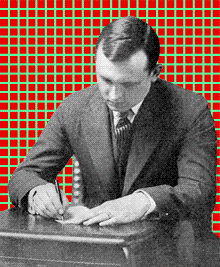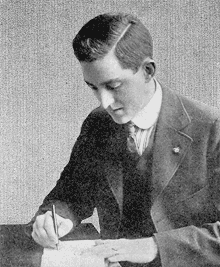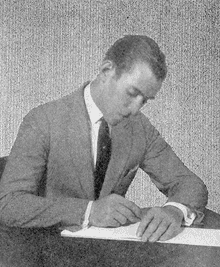Audience of One: Gregg Shorthand and the Scene of Phonography
By Jonathan Boggs
Robert Creeley’s revelation of an unwritten self that “wants to/be free but/impassive lies/in the direction/of its/words” 1 suggests a purpose for writing that has been unimaginable for quite some time.
But before we do try to imagine it, we’ll have to say something about the general consensus that has marked off writing’s territory at least since the poststructuralist 60s.
As a trailblazer in the psychological-realist interpretation of literary history, Harold Bloom is a good place to start. His opening remarks in the Map of Misreading are devoted to persuading the reader that the hyper-belated, “all-but-impossible” situation inherited by today’s poets and critics is a creative one:
[Literary tradition] is now valuable precisely because it partly blocks, because it stifles the weak, because it represses even the strong. . . . Nietzsche insisted that nothing was more pernicious than the sense of being a latecomer, but I want to insist upon the contrary: nothing is now more salutary than such a sense. Without it, we cannot distinguish between the energy of humanistic performance and merely organic energy, which never alas needs to be saved from itself. 2
This last distinction between two types of energy—one useful for writing, the other not—tells us a lot. For one thing, his disavowal of “merely organic energy” would seem to preclude all forms of non-psychological, non-self-identifying life from the task of writing. Quite a few worlds indeed—not least of which is that “system of conditioning influences that the individual assumes” 3 —the body. Bloom’s rationale for such an omission is that all such nonhuman energy “never alas needs to be saved from itself.” A bit of strong soteriology that leads directly into the whole psycho-philosophical complex in which contemporary writing is now stuck.
 The Modern Daemon of Writing
The Modern Daemon of Writing
When Derrida undertook to make room for writing “in the beginning” alongside the spoken logos, or phone, he was trying to liberate the struggling writer, subject, self that Freud created when he discovered the superego/ego/id complex:
Writing, as Derrida tropes it, both keeps us from the void and, more aggressively (as against voicing), gives us a saving difference, by preventing that coincidence of speaker with subject that would entrap us in a presence so total as to stop the mind. 4
Salvation after Nietzsche, then, has nothing to do with unity. If premodern man was hearing God and therefore urged to accommodate presence; modern man was hearing voices and therefore urged to assimilate madness. In such a context, phone is a loaded idea—a code word for the psyche’s victimization by involuntary mediumship:
[Phonetic writing’s] complicity with logos (or the time of logic), which is dominated by the principle of noncontradiction, the cornerstone of all metaphysics or presence, is profound. Now in every silent or not wholly phonic spacing out of meaning, concatenations are possible which no longer obey the linearity of logical time, the time of consciousness or preconsciousness, the time of “verbal representations.” 5
The engine of Derrida’s poetics, like Freud’s before him, is the agon between the impression of a transcendent, individuality-erasing God and the expression of enlightened, therapeutic man—who tragically marks his freedom with the instruments of noncontradiction. Existentially at variance with the primal, monotheistic, preconscious phone, the modern writer has no choice but to create the belated, atheistic, self-conscious text.
 Stenography and the Retooling of Writing
Stenography and the Retooling of Writing
In 1888, the young John Robert Gregg was exhibiting none of the phone anxiety that was so plaguing the patients of his Austrian contemporary Freud. The 21 year-old Irish stenographer had just published a pamphlet called Light-Line Phonography and five years later would be touring the U.S., rapidly gaining adoptions for Gregg Shorthand in high schools from coast to coast. 6
A publisher and editor as well as a teacher and inventor, Gregg went on to edit the Gregg Writer magazine and found the Gregg Publishing Company. One of the more theoretically interesting publications in the Gregg literature is Gregg Speed Studies, published in 1917 by the Gregg Publishing Company. A tachygraphic (quick writing) drill-book designed to supplement the Gregg Shorthand Manual, the Speed Studies, particularly in its introductory essay “Foundations of Speed and Accuracy,” is a disarming invitation to self-interrogation.
This quality is due in large part to Gregg’s persuasive use of late nineteenth century philosophical psychology. He quotes generously from the “late Professor [William] James, the great psychologist of Harvard University”:
Could the young but realize how soon they will become mere walking bundles of habits, they would give more heed to their conduct while in the plastic state. We are spinning our fates, good or evil, never to be undone.
And:
The great thing in all education is to make our nervous system 7 our ally instead of our enemy. We must make automatic and habitual as many useful actions as we can, and guard against growing into ways that are likely to be a disadvantage to us. The more the details of our daily life we can hand over to the effortless custody of automatism, the more our higher powers of mind will be set free for their own proper work. 8
What we receive here, and in the very subtle, mechanical direction to come, is a strong impression of stenography as a Transcendentalist device. 9
 The Nonmodern Demon of Writing
The Nonmodern Demon of Writing
We have argued that modern and postmodern writing achieves its vertiginous depths by confining itself to a single world—the densely populated world of the psyche.
Through stories of the ascetic practices of the monachos, or solitary one, Athanasius’ hagiographic text The Life of St. Antony, equips us with the “primal scene” of another writing. 10 It depicts an anthropology strikingly similar to the one we have seen, but with a key difference:
So having grown stronger and stronger in his purpose, he hurried to the mountain. On the far side of the river he found a deserted fort which in the course of time had become infested with creeping things. There he settled down to live. The reptiles, as though someone were chasing them, left at once. . . .
His acquaintances who came to see him often spent days and nights outside, since he would not let them come in. They heard what sounded like riotous crowds inside making noises, raising a tumult, wailing piteously and shrieking: “Get out of our domain! What business have you in the desert? You cannot hold out against our persecution.” At first those outside thought there were men fighting with him and that they had entered in by means of ladders, but as they peered through a hole and saw no one, they realized that demons were involved; and filled with fear, they called out to Antony. But he was more concerned over hearing them than to pay any attention to the demons. Going close to the door he suggested to them to leave and to have no fear. “It is only against the timid,” he said, “that the demons conjure up spectres. You, now, sign yourselves and go home unafraid, and leave them to make fools of themselves.” 11
If this story does indeed function as a Scene of Instruction for nonmodern poetics, Antony’s weird impassibility is bound to have its contemporary analogues. We’ll take just two examples.
In 2001 the novelist Richard Ford was asked to describe his relationship to his characters. His reply is now infamous: “Master to slave. Sometimes I hear them at night singing over in their cabins.” 12
During one of Robert Duncan’s breathless lectures at the Jack Kerouac School, the poet describes his response to “intruding lines”:
In the first place I would put the lines away if I had something to do. I have responsibilities, yes, that are primary to a poem. [But] I told Jack Spicer, which shocked him, because he was willing to feed his life into the maw of that vast stupidity called poetry, that I’d strangle poetry if it interfered with my household. . . . I’m not impressed with powers. . . . And why do I even propose that to myself? Because many a poet has not only destroyed his life—which I think, well ok, there are too many lives, or lots of lives—but he has also destroyed households. He’s destroyed happiness. He’s destroyed universes. In order to feed a poem. Can you see how appalling and stupid that is? Why would you feed a poem? . . .
I’m my most local household, am I not? And I’m crossing a street. My primary responsibility. My response—ability to respond—when I’m crossing a street is getting across the street and not scaring the cars. . . . And so we do have another poetry that we inhabit—that we keep our responses alive. And so those intruding lines: in a poem I can work with them, but when they cross into the actual . . . . Yeah, I observe the actual as paramount. There’s only one time you get to do that one.
[Now,] writing the poem is actual. 13
Duncan’s reference to Spicer underscores the difference between superstitious and critical attitudes toward the imagination. While Jack Spicer indulged the idea of automatic writing, writing as occult dictation, Robert Duncan consistently maintained a distance from self-annihilating views of inspiration. He sought to balance the “vatic” poet of monotheistic traditions against the “weaver,” fabricator poet of Greek dramatic and oral storytelling traditions.
The only rule of Duncan’s cult of poetry was conscious cooperation with the “everlastingly generative field that language is.” But this “open field” notion of language is not intended to be a mystification. As Duncan’s logic suggests, a superstitious attitude about the field of language—about one’s own possible origin in, and immanent return to, that field—results in an “appalling” psychological intensification of the poem itself. When the poet makes an egregore of the poem in this way, Duncan suggests, the poet’s responsibility to “the actual” is weakened. And the poet’s ego is thereby forced, in Freud’s words, “to undertake a fresh effort of repression” against the act of writing itself. 14
To return to the idea of writing as an ontological performance, therefore, is to join Duncan in equating it with “the actual,” the life-scene which “occurs over a time which will not be repeated.”15
 Writing Between Worlds, or “Passing From One Outline to Another”
Writing Between Worlds, or “Passing From One Outline to Another”
The introduction to the Speed Studies manual features a number of photographs doctored to emphasize the sitter’s body. Gregg invites the reader to contemplate the posture and hand position of such 1920s shorthand adepts like: Mr. Charles L. Swem, personal stenographer to Woodrow Wilson and world shorthand champion, 1923 and 1924; Mr. Albert Schneider, world shorthand champion, 1921; Frederick H. Gurtler, ex-president of the National Shorthand Reporters’ Association; Salome Lanning Tarr, world record holder for accuracy at the Fifth International Shorthand Speed Contest; Joseph M. Shaffer, former reporter to the “Honorable Wm. G. McAdoo”; and most compellingly, Mr. Martin J. Dupraw, who “at the age of nineteen . . . won the World’s Shorthand Championship in August, 1925, with the Highest Accuracy ever made in any championship contest,—99.91%.” Unlike the others, Mr. Dupraw is pictured from the chest up, facing the camera squarely, as if the reader is invited to contemplate the enigma of discipline in youth.
Gregg’s text has an energy that can only come from the mind of an acute and morally serious pedagogue. He is uncompromising on the subject of attention. The beginning student, we find, faces serious consequence when she breaks concentration to follow one of the numerous escape routes afforded by the body. Once again following William James, Gregg instructs the initiate to “never suffer an exception” in the early stages of writing and to respond without delay to “every emotional prompting . . . in the direction of habits you aspire to gain.” 16
His warnings against slumping, leaning, twisting the foot around a chair leg, pen-gripping and incorrect weight distribution all go back to “the elimination of waste mechanical energy.” His instructions keep threading back to the Jamesian reservoir of “nervous energy” without the fastidious guardianship of which, the student is lost.
The section entitled “Passing from one outline to another,” is a testimony to Gregg’s subtlety as an observer:
By observing the work of poorly trained writers it will be seen that the pen makes several unnecessary movements at the completion of each wordform—the writer seemingly trying to get a running start by making several movements in the air. These movements result in a loss of valuable nervous energy. They are generally the result of the hesitation caused by trying to recall principles or wordsigns of which the writer has but a hazy recollection. 17
This passage begins to open up an erotics of shorthand—allowing room for an ideological leap from a utilitarian vision of nervous energy to a magical one which would regard the events of emotional experience as a necessary humiliation—a momentary opportunity to descend to the floor of evolutionary, non-mundane work.
The shock of reading Speed Studies, therefore, lies with the teacher’s successful construction of an embodied, moral world into which the reader is already thrown. Like the Emersonian tracts evidently imprinted on the mind of its author, the manual holds up a mirror and lures out a will to change. This “trick,” of course, is merely an evocation of moral space—a field where right and wrong are irresistible fictions, like rules of a game. Attached to a skill—a viable program of self-writing—morality is momentarily dislodged from its sequestration in the dogmatic, dualistic imagination and made nondual. It rouses the will to work-with-what-one-has in the hope of crossing into new territory. It reconstitutes something childlike, the Student as interior image. A place where wanting to know how is all. 18
Conclusion: Writing in the “Place of Asceticism”
Beginning with Freud’s discovery of the unconscious, carrying on through Lacan’s revelation that the unconscious is structured like a language and coming to completion in Derrida’s “there is no psyche without text,” the principle legacy of the twentieth-century marriage of literary theory and psychoanalysis was to forfeit the art of writing into the hungry, ever-widening mouth of the modern psyche.
If we take writing out of that disembodied, agonistic domain and transpose it into an embodied, amateur-istic domain like stenography, or tachygraphy, we make it possible for writing to again serve the purposes of human development.
Like St. Antony—our eremitic figure of the artist—writing must perform an anachoresis from the “society” of the psyche into the desert of the soul: “having thus taken his fill, he would return to his own place of asceticism.” 19
Brought back into a relationship with language (understood as an energetic, Duncan-like “meadow,” a proper domain of Nature), writing would thus be restored to its status as a genuine technology.
Notes
1. See shorthand text #3.
2. Harold Bloom, The Map of Misreading (New York: Oxford University Press, 2003), 29.
3. Mircea Eliade, The Sacred and the Profane (New York: Harcourt, 1959), 173.
4. Bloom, The Map of Misreading, 43, (my emphasis).
5. Jacques Derrida, “Freud and the Scene of Writing,” in Writing and Difference, trans. Alan Bass (Chicago: University of Chicago Press, 1978), 217.
6. Not all alphabets in the history of shorthand were phonetic. Gregg’s decision to combine phonetic spelling with the curvilinear movement of simple longhand, reflects not only his intention to develop a system for dictation, but a very Platonic intuition that nothing wakes a mental image like sound.
7. For a connection between the nervous system and the traditional idea of demons, see Jacob Needleman, “Magic, Sacrifice and Tradition,” in Consciousness and Tradition (New York: Crossroad, 1982), 121–122.
8. John R. Gregg, Gregg Speed Studies (New York: Gregg Publishing Company, 1917), 2-4.
9. For a discussion of William James’s relationship to the Spiritualism, Theosophy and New Thought of his time, see Catherine L. Albanese, Republic of Mind and Spirit (New Haven: Yale University Press, 2007), 413–423.
10. In contrast to Derrida’s alienated “Scene of Writing” and Bloom’s dualistic “Primal Scene of Instruction.”
11. Bernard McGinn, ed., The Essential Writings of Christian Mysticism (New York: Modern Library, 2006), 52–53.
12. Michael Dirda, review of Canada, by Richard Ford, New York Review of Books, July 12, 2012.
13. Robert Duncan, “Warp and Woof,” lecture, Jack Kerouac School of Disembodied Poetics, Boulder, CO, June 10, 1976, Naropa Poetics Audio Archives.
14. Sigmund Freud, The Problem of Anxiety, (quoted in Bloom, Map of Misreading, 49).
15. See shorthand text #2.
16. Gregg, Gregg Speed Studies, 4.
17. Ibid., 13.
18. As a tachygraphic practice, or “speed study,” shorthand invites a helpful distinction between two kinds of speed. There is the disembodied, violent “Promethean” or technology-based order of speed and there is the less familiar embodied, sympathetic “Orphic” or art-based order of speed, which is a “quickness,” a manifestation of the “quickening spirit.” For a discussion of the former, see Paul Virilio, Speed and Politics (Los Angeles: Semiotext(e), 2006).
19. Bernard, Essential Writings of Christian Mysticism, 51.
Images
1. Photo of Mr. Charles L. Swem, ca. 1917, Gregg Speed Studies, viii, scan courtesy of Jonathan Boggs. GIF animation, 2013, Janelle Rebel.
2. Photo of Frederick H. Gurtler, ca. 1917, Gregg Speed Studies, 7, scan courtesy of Jonathan Boggs. GIF animation, 2013, Janelle Rebel.
3. Photos of Albert Schneider and Salome Lanning Tarr, ca. 1917, Gregg Speed Studies, 3, 11, scans courtesy of Jonathan Boggs. GIF animation, 2013, Janelle Rebel.
4. Photos of Joseph M. Shaffer and Mr. Martin J. Dupraw, ca. 1917, Gregg Speed Studies, 18, 16, scans courtesy of Jonathan Boggs. GIF animation, 2013, Janelle Rebel.